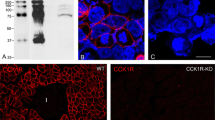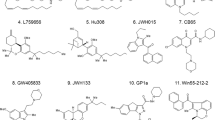Abstract
D,l-4-(3,4-dichlorobenzoylamino)-5-(N-3-methoxypropyl-pentylamino)-5-oxopentanoic acid (CR 1505; loxiglumide) is a newly developed analog of proglumide. We examined the inhibitory effects of loxiglumide on pancreatic exocrine function in the isolated pancreatic acini and the isolated perfused pancreata of rats. Loxiglumide inhibited cholecystokinin octapeptide (CCK-8)-stimulated amylase release and, similarly, binding of[ 125 I]CCK-8 to isolated rat pancreatic acini. Loxiglumide was about 3000 times more potent than the reference substance proglumide, but was about 1000 times less potent than L-364,718, another new CCK antagonist having benzodiazepine ring, in inhibiting CCK-8-stimulated amylase release. The inhibitory effect of loxiglumide displayed competitive kinetics and was specific for CCK in that the effects of other receptor secretagogues or agents bypassing receptors were not altered. The inhibitory effect of loxiglumide was fully reversible in isolated acini. However, the pancreata perfused with 10 μM loxiglumide for 20 min did not respond to CCK-8 for more than 20 min even after the removal of loxiglumide infusion. In contrast, an immediate increase in pancreatic exocrine secretion was observed after proglumide removal. Loxiglumide appeared to be bound to the receptors on acinar cells in a slowly dissociating state. These results indicate that loxiglumide acts as a potent, competitive, and specific CCK antagonist on the exocrine pancreas and, because of its prolonged inhibitory action, may be useful as a therapeutic agent in pancreatic disease.
Similar content being viewed by others
References
Steer ML, Meldolesi J: The cell biology of experimental pancreatitis. N Engl J Med 316:144–150, 1987
Peikin SR, Costenbader CL, Gardner JD: Actions of derivatives of cyclic nucleotides on dispersed acini from guinea pig pancreas. Discovery of a competitive antagonist of the action of cholecystokinin. J Biol Chem 254:5321–5327, 1979
Otsuki M, Okabayashi Y, Ohki A, Nakamura T, Tani S, Fujii S, Oka T, Sankaran H, Baba S: Effect of Bt2cGMP on action of cholescystokinin in isolated perfused rat pancreas. Am J Physiol 251:G293-G299, 1986
Hahne WF, Jensen RT, Lem PH, Gardner JD: Proglumide and benzotript: Members of different class of cholecystokinin receptor antagonists. Proc Natl Acad Sci USA 78:6304–6308, 1981
Lignon MF, Galas MC, Rodriguez M, Laur J, Aumelas A, Martinez J: A synthetic peptide derivative that is a cholecystokinin receptor antagonist. J Biol Chem 262:7226–7231, 1987
Spanakel M, Martinez J, Briet C, Jensen RT, Gardner J: Cholecystokinin-27-32-amide. A member of a new class of cholecystokinin receptor antagonists. J Biol Chem 258:6746–6749, 1982
Change RSL, Lotti VJ, Monaghan RL, Birnbaum J, Stapley EO, Goetz MA, Albers-Schonberg G, Patchett AA, Liesch JM, Hensens OD, Springer JP: A potent non-peptide cholecystokinin antagonist selective for peripheral tissues isolated from Aspergillus alliaceus. Science 230:177–179, 1985
Chang RSL, Lotti VJ: Biochemical and pharmacological characterization of extremely potent and selective nonpeptide cholecystokinin antagonist. Proc Natl Acad Sci USA 83:4923–4926, 1986
Chang RSL, Lotti VJ, Chen TB, Kunkel KA: Characterization of the binding of [3H]-(1)-L364718: A new potent non-peptide cholecystokinin antagonist radioligand selective for peripheral receptors. Mol Pharmacol 30:212–217, 1986
Weiss J, Miederer SE (eds): Proglumide: Gastrin-Receptor Antagonist. Amsterdam, Excerpta Medica, 1980
Jensen RT, Murphy RB, Trampota M, Schneider LH, Jones SW, Howard JM, Gardner JD: Proglumide analogues: Potent cholecystokin in receptor antagonists. Am J Physiol 249:G214-G220, 1985
Makovec F, Chiste R, Bani M, Pacini MA, Setnikar I, Rovati L: New glutaramic acid derivatives with potent competitive and specific cholecystokinin-antagonistic activity. Arzneim Forsch (Drug Res) 35:1048–1051, 1985
Jensen RT, Zhou ZH, Murphy RB, Jones SW, Setnikar I, Rovati LA, Gardner JD: Structural features of various proglumide-related cholecystokinin receptor antagonists. Am J Physiol 251:G839-G846, 1986
Niederau C, Niederau M, Williams JA, Grendel JH: New proglumide-analogue CCK receptor antagonists: Very potent and selective for peripheral tissues. Am J Physiol 251:G856-G860, 1986
Makovec F, Bani M, Chiste R, Rovati LC, Rovati LA: Differentiation of central and peripheral cholecystokin in receptors by new glutaramic acid derivatives with cholecys-tokinin-antagonistic activity. Arzneim Forsch (Drug Res) 36:98–102, 1986
Hosotani H, Chowdhury P, McKay D, Rayford PL: Effect of L364718, a new CCK antagonist, on amylase secretion in isolated rat pancreatic acini. Pancreas 3:95–98, 1988
Williams JA, Korc M, Dormer RL: Action of secretagogues on a new preparation of functionally intact, isolated pancreatic acini. Am J Physiol 235:E517-E524, 1978
Otsuki M, Williams JA: Effect of diabetes mellitus on the regulation of enzyme secretion by isolated rat pancreatic acini. J Clin Invest 70:148–156, 1982
Ceska M, Birath K, Brown B: A new and rapid method for the clinical determination of α-amylase activities in human serum and urine. Clin Chim Acta 26:437–444, 1969
Sankaran H, Goldfine ID, Deveney CW, Wong KY, Williams JA: Binding of cholecystokinin to high-affinity receptors on isolated rat pancreatic acini. J Biol Chem 255:1849–1853, 1980
Sankaran H, Goldfine ID, Bailey AC, Licko V, Williams JA: Relationship of CCK receptor binding to regulation of biological functions in pancreatic acini. Am J Physiol 242:G250-G257, 1982
Dehaye JP, Winand J, Poloczek P, Christophe J: Characterization of muscarinic cholinergic receptors on rat pancreatic acini byN-[3H]methylscopolamine binding. J Biol Chem 259:294–300, 1984
Lowry OH, Rosebrough NJ, Farr AL, Randall RJ: Protein measurement with Folin-phenol reagent. J Biol Chem 193:265–275, 1951
Otsuki M, Sakamoto C, Yuu H, Maeda M, Morita S, Ohki A, Kobayashi N, Terashi K, Okano K, Baba S: Discrepancies between the doses of cholecystokinin or caerulein-stimulating exocrine and endocrine responses in perfused isolated rat pancreas. J Clin Invest 63:478–484, 1979
Okabayashi Y, Otsuki M, Ohki A, Sakamoto C, Baba S: Effects of C-terminal fragments of cholecystokinin on exocrine and endocrine secretion from isolated perfused rat pancreas. Endocrinology 113:2210–2215, 1983
Schild HO: Drug-receptor interactions.In Applied Pharmacology. HO Schild (ed). Edinburgh, Churchill Livingstone, 1980, pp 5–18
Jensen RT, Moody T, Pert C, River JE, Gardner JD: Interaction of bombesin and litrin with specific membrane receptors on pancreatic acinar cells. Proc Natl Acad Sci USA 75:6139–6143, 1978
Christophe JP, Conlon TP, Gardner JD: Interaction of porcine vasoactive intestinal peptide with dispersed pancreatic acinar cells from the guinea pig. Binding of radioiodinated peptide. J Biol Chem 251:4629–4634, 1976
Author information
Authors and Affiliations
Additional information
This work was supported in part by a grant from the Japanese Ministry of Health and Welfare (Intractable Diseases of the Pancreas).
Rights and permissions
About this article
Cite this article
Otsuki, M., Fujii, M., Nakamura, T. et al. Loxiglumide. Digest Dis Sci 34, 857–864 (1989). https://doi.org/10.1007/BF01540270
Received:
Revised:
Accepted:
Issue Date:
DOI: https://doi.org/10.1007/BF01540270




